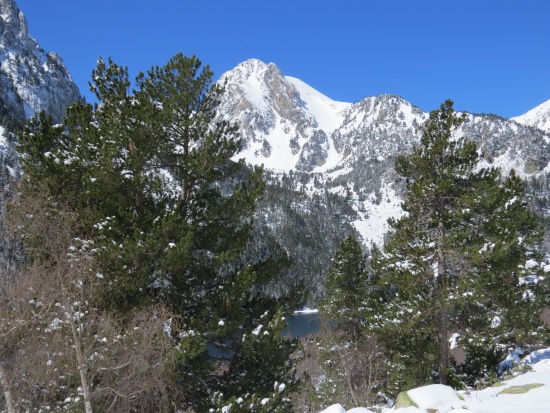| This article is incomplete. This article is missing one or more sections. You can help the BirdForum Opus by expanding it. |
Overview
A wild and rugged, glacier-scarred area in the central Pyrenees with boulder-strewn hillsides, hanging valleys and high peaks, reaching 2,957 m at Contraig. The park's Catalan name means 'twisting waters' and refers to the many streams, which zigzag down from the mountains through dense forests.
The main features of the park are two large valleys, San Nicolau in the northwest and Escrita in the northeast, separated by a high mountain pass, the Portarro d'Espot. Lake San Mauricio, a popular tourist attraction in summer, lies in the valley of the Escrita River, a steep-sided glacial valley with a series of lakes and forests of Scots Pine Pinus sylvestris, Mountain Pine Pinus mugo subsp. uncinata, Silver Fir Abies alba, birch Betula, and willow Salix.
There are also areas of moorland with Heather Calluna vulgaris, Broom Cytisus sp., and Alpenrose Rhododendron ferrugineum, as well as bare peaks and scree-slopes in the higher parts. The San Nicolau valley has similar habitats with hayfields in the lower areas and many patches of mixed and coniferous woodland. Higher up there are plains formed by silted-up lakes.
Other places of interest nearby include thermal springs at Caldas de Bohi, and the remains of 11th and 12th century churches and hermitages.
Birds
Notable Species
Lammergeier is present and usually fairly easy to see and other raptors include Griffon Vulture, Golden Eagle and Eurasian Goshawk. There is a good range of typical mountain species such as Rock Ptarmigan, Northern Raven, both choughs, Wallcreeper and Alpine Accentor as well as Water Pipit and Rock Bunting.
The birds of the coniferous forest include Capercaillie, Tengmalm's Owl and Black Woodpecker, Common Firecrest, Common Crossbill and Citril Finch. Coal Tit and Crested Tit and both treecreepers are common.
In the lower areas of meadows and deciduous woodland there are Golden Oriole, Red-backed Shrike and Yellowhammer.
Checklist
Birds you can see here include:
European Honey Buzzard, Black Kite, Red Kite, Lammergeier, Griffon Vulture, Short-toed Eagle, Eurasian Goshawk, Eurasian Sparrowhawk, Common Buzzard, Golden Eagle, Common Kestrel, Peregrine Falcon, Rock Ptarmigan, Western Capercaillie, Grey Partridge, Red-legged Partridge, Eurasian Woodcock, Great Eagle Owl, Tengmalm's Owl, Common Kingfisher, Eurasian Hoopoe, Black Woodpecker, Eurasian Crag Martin, Water Pipit, Grey Wagtail, Common Dipper, Dunnock, Alpine Accentor, Whinchat, Black Redstart, Rufous-tailed Rock Thrush, Blue Rock Thrush, Ring Ouzel, Mistle Thrush, Melodious Warbler, Garden Warbler, Western Bonelli's Warbler, Iberian Chiffchaff, Goldcrest, Common Firecrest, Marsh Tit, Coal Tit, Crested Tit, Eurasian Nuthatch, Wallcreeper, Common Treecreeper, Short-toed Treecreeper, Red-backed Shrike, Eurasian Golden Oriole, Common Jay, Alpine Chough, Red-billed Chough, Northern Raven, White-winged Snow Finch, Eurasian Tree Sparrow, Rock Sparrow, European Serin, Citril Finch, Eurasian Siskin, Common Crossbill, Common Bullfinch, Yellowhammer, Rock Bunting
Other Wildlife
The flora is rich and colourful especially in the alpine meadows at the timberline and includes the Yellow Turk's Cap Lily, Martagon Lily and many saxifrages and gentians. Houseleeks are common over large areas and the insectivorous sundews and butterworts occur along riverbanks and in wet meadows.
Mammals of the park include Pyrenean Chamois Rupicapra pyrenaica and Wild Boar Sus scrofa, Wildcat Felis silvestris, Red Fox Vulpes vulpes, Badger Meles meles, Otter Lutra lutra and Stoat Mustela erminea, Pine Marten Martes martes and Beech Marten Martes foina, Red Squirrel Sciurus vulgaris and the seldom-seen Pyrenean Desman Galemys pyrenaicus. Brown Bear Ursus arctos from a reintroduction programme just across the border in France have wandered into the park.
Butterflies are varied and include species such as Black-veined White Aporia crataegi, apollos, swallowtails and fritillaries. Wall Lizard Podarcis muralis is common throughout the lower areas and amphibians found in the park include Midwife Toad and Pyrenean Brook Salamander.
Site Information
The best time to visit the park from a birding point of view is from mid-May until the end of June. Even during this period some parts of the park may be overrun with tourists but later in the summer it is necessary to start early in the morning to avoid the crowds at places such as Lake San Mauricio. However, the park has a good network of marked hiking trails which enable birders to escape from the most frequented routes.
History and Use
To do
Areas of Interest
To do
Access and Facilities
The Escrita Valley is best visited from the village of Espot signposted from the C147. The village has campsites and hostel accommodation but within the park itself camping is restricted to specified refuges including one at Lake San Mauricio. There is a park information centre in Espot with all the necessary details.
The lake can be reached by road from Espot and a trail continues from the lake through forest and up to subalpine woodland and meadows. Further on there are more lakes and open, truly alpine habitat and there is a mountain refuge hut beside the lake at Amitges.
The San Nicolau valley can be reached from Pont de Suert on the N230, heading towards the Aran Valley and turning right after a few km for Caldes de Boi. From here the villages of Boi (Bohi) and Erill-la-Vall are signposted, both of which have hostel accommodation and restaurants.
There are campsites at Llong Lake and Barruera. The valley can be explored via a forestry trail which begins just north of Boi and goes up the valley through the different vegetation zones, past lakes and alongside the river up to an altitude of almost 2,000m.
Contact Details
To do
External Links
Content and images originally posted by Steve




